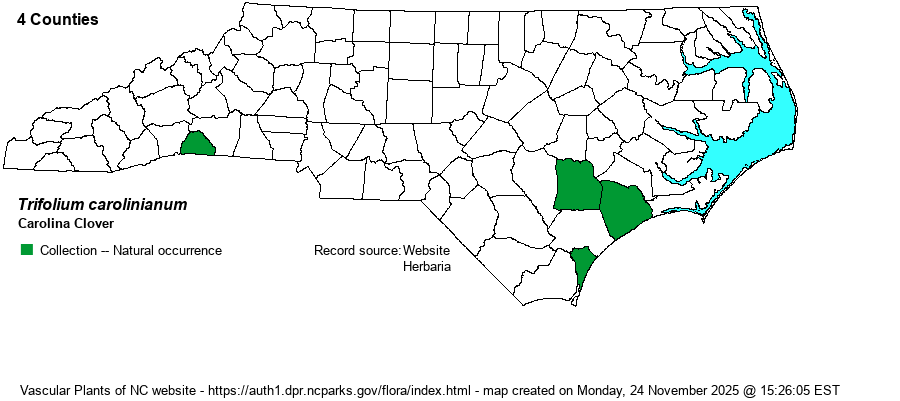| Author | Michaux | |
| Distribution | Formerly occurred in a few sites in the southeastern Coastal Plain, but no valid records in 80 years; also a 1952 collection record for the southwestern Piedmont (Polk County). There are SC records for counties in the Sandhills/lower Piedmont region adjacent to the NC border (e.g., Chesterfield and Lancaster), and thus re-discovery in NC might be more likely in Anson or Richmond counties as opposed to near the coast.
This is a Southern species found currently from SC south to northern FL, and west to eastern OK and central TX. It does range well inland to the south of NC.
| |
| Abundance | Long historical in the state. The three records in the NCNHP database are from 1899, 1936, and 1940. The Polk County specimen was collected from the Broad River in 1952. The Robeson County specimen was collected in 2002 but is misidentified. Perhaps the reasons that the NCNHP has not given it the SX (Extirpated) State Rank are 1) it still seems to be present in SC right up to the NC border, and 2) it is a small species that can easily be overlooked as White Clover (T. repens) or several other non-native species when not in bloom. It is essentially unknown to NC biologists, as practically no one in the state is familiar with this native species. Not surprisingly, the species has a State Special Concern - Historical status in NC. | |
| Habitat | This is a species of sandy soil, mostly along woodland edges, margins of outcrops, and sandy openings in upland woods. | |
| Phenology | Blooms from April into July and fruits soon after blooming. The NC records are mainly from late April (when presumably they were in bloom). | |
| Identification | This is a small species, easily passed over by most people as White Clover or some other non-native clover species, even if in bloom. It is a slender species that grows in clumps to about 6-8 inches tall, at best; it can be erect but it often is leaning or decumbent owing to very slender and wiry stems. It has some branching, with the 3 leaflets being quite small (= tiny) and distinctly serrated on the outer half (toward the tip). The leaflets are obovate (rounded but wider beyond the middle), only about 1/4-inch long, and about 1/5-inch wide. When in bloom, it has a quite long stalk for the small size of the plant, it reaching about 4 inches and containing the typical "clover head" at the end. The rounded cluster is about 1/2-inch across and light purple, pink, or white in color; the color can be hard to detect from much distance. (Don't expect to see a bright purple head of flowers!). It isn't quite time to "throw in the towel" on the species turning up again in NC, but botanists and other biologists must be quite attentive to small clover-like plants in the southern Coastal Plain, in case they run across some plants (in bloom) that do not quite look right for White Clover. There are several other non-native species of clovers with very small leaflets that are serrated on the outer margins, but these -- T. campestre and T. dubium -- have yellow flowers. | |
| Taxonomic Comments | None
Trifolium is a large genus of some 240-250 species globally, mostly north-temperate zone. Most are readily recognized as a clover by their 3 broad leaflets and globular to hemispherical head of densely-packed flowers. Flowers vary from white to pink, and red; the hop clovers have tiny yellow flowers. Some species were introduced for their forage value for livestock, others hitched a ride with hay, packing material, etc. Our two native species -- T. carolinianum and T. reflexum -- have suffered great loss of habitat and are now rare. | |
| Other Common Name(s) | Wild White Clover | |
| State Rank | SH | |
| Global Rank | G5 | |
| State Status | SC-H | |
| US Status | | |
| USACE-agcp | | |
| USACE-emp | | |

